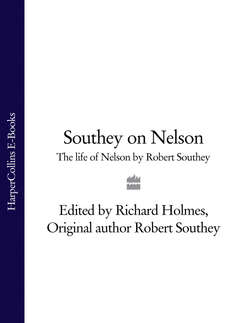Читать книгу Southey on Nelson: The Life of Nelson by Robert Southey - Richard Holmes - Страница 6
3
ОглавлениеBut Nelson had become a legend, above all, because of his charismatic personality. For the English public, his whole life was seen as one unbroken act of heroism, starting as a fifteen-year-old midshipman fighting a polar bear on an artic ice flow, and continuing without check until Trafalgar some thirty years later. Yet in fact neither recognition nor success came quickly to Nelson.
After mixed service in the West Indies, South America, the Baltic, Canada and the Caribbean, Nelson was a seasoned officer and a post-captain at the age of thirty. But he had never yet commanded a ship larger than a small frigate, the twenty-eight-gun Boreas; he suffered from sea-sickness, recurrent malaria, and severe bouts of depression; and he frequently considered resigning from the Service. For five years between 1788 and 1792, he was simply an unemployed navy officer, quietly married but without children, and living on half-pay at his father’s rectory, in the remote Norfolk village of Burnham Thorpe. On Saturdays he would ride three miles to the little tidal harbour of Overy Staithe, to sit on the sea wall, read the Navy Chronicle and watch the fishing boats.
It was not until the outbreak of war with revolutionary France, that he was given command of the sixty-four gun frigate the Agamemnon, in January, 1793. He served quite successfully in the Mediterranean, notably on the Corsica station in 1794, but he lost the sight of his right eye at the siege of Calvi, and his general health continued bad. It was only three years later that Nelson first really made his distinctive mark at the battle of Cape St Vincent in February, 1797, when he disobeyed his commander Sir John Jervis (later Lord Vincent) by breaking the battle line–‘without a moment’s hesitation’—to sail directly and alone into the huge Spanish fleet. He was promoted Rear Admiral, and appointed a Knight of the Bath. However later that year, while leading a bloody sea-borne landing at Santa Cruz in July, he lost his right arm.
The following year, 1798, he was at last given his first major command aboard his flagship the seventy-four gun Vanguard. He pursued the French fleet relentlessly back and forth across the Mediterranean. He finally trapped it outside Alexandria, anchored in Aboukir Bay. In a dazzling display of seamanship he annihilated what had been Napoleon’s Egyptian invasion fleet, at the Battle of the Nile in August 1798. This was the first great strategic British victory against revolutionary France. Gillray cartooned Nelson sweeping the enemy from the seas with a crocodile for a cudgel, and from now on his reputation spread like wild-fire among the general public.
His exploits were for the first time widely reported in the daily papers, including the newly founded The Times, which ran gossip items about him as well as battle reports. Nelson found that, unlike most other naval commanders who cultivated bluffness and understatement (like his great friend the taciturn Cuthbert Collingwood), he had a natural gift for extravagant publicity. He was a master of the peremptory official dispatch to his superiors, and the vivid post-action narrative rapidly and skilfully composed, for the benefit of the Admiralty. His account of ‘Nelson’s Patent Bridge’ for boarding enemy ships at Cape St Vincent, was celebrated in the fleet for its cheek, and quickly appeared in The Times. His description (not unbiased) of his tactics at Aboukir Bay, and the explosion of the huge French flagship L’Orient at night, was so famous that Turner painted a picture of it.
Nelson understood the essentially dramatic nature of naval command, and the natural theatre of the quarterdeck. Here a captain not only commanded an entire ship’s company for months on end, but also performed for its benefit. Time and again, in the heat and roar of action (when few men could even think clearly), Nelson not only demonstrated his extraordinary coolness, but proved he had a genius for producing the symbolic gesture and the memorable phrase: ‘A laurel or a cypress for my head’; ‘Westminster Abbey or victory’. His words and gestures before and during his last two great battles, Copenhagen (April 1801) and Trafalgar (October, 1805), became so widely known, almost proverbial, that later historians have sometimes treated them as folklore.
Yet Nelson was something of an historian himself. He kept very full diaries, and wrote brilliant descriptive and often highly emotional letters about his battles. These were not only sent to his friends and family, but also to his fellow officers and superiors, and were frequently leaked to newspapers. In fact diary-keeping and letter-writing (often later extended to memoirs) became characteristic of British naval officers of this period, just as a century later they would become characteristic of military officers on the Western Front. English naval writing during the Napoleonic War forms a literature of its own, and has subsequently inspired an entire maritime sub-genre of the modern historical novel, from C.S. Forester’s Hornblower series to Patrick O’Brian’s Jack Aubrey saga.
For Nelson, writing and deliberate phrase-making became an important expression of his turbulent personality and, increasingly, his sense of mission. It was he, and not a fellow officer, who invented ‘the Nelson touch’ in 1805, with its deliberate echo of Shakespeare’s ‘little touch of Harry in the night’ from Henry V; and it was he who adopted Shakespeare’s phrase, ‘we band of brothers’. It is significant that he kept his diary in duplicate so that it should not be lost and that in the last ninety minutes before action was joined at Trafalgar he wrote out his final diary entries, his testament, and his long battle prayer, in his own clear racing longhand, twice in full without a single alteration.
